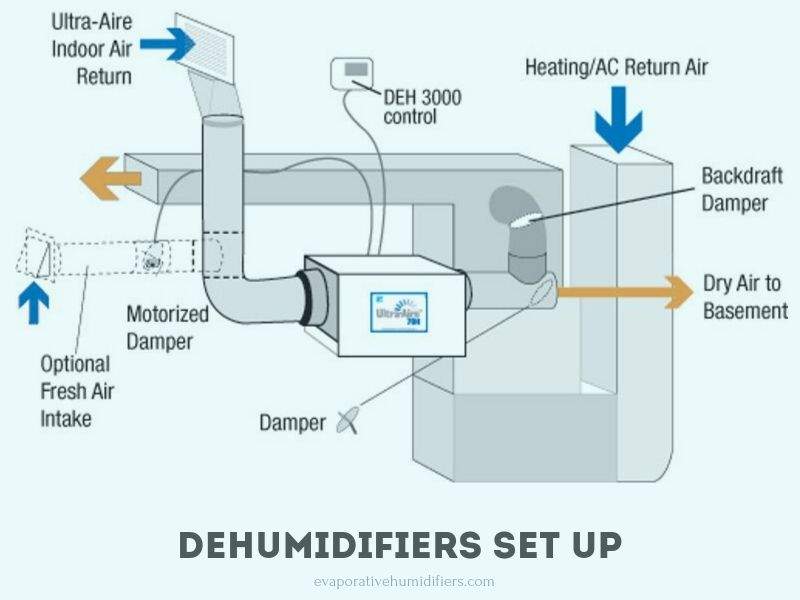Last Updated: February 21, 2025
High humidity can be a bother, and having a dehumidifier saves you all the troubles that come with it. A dehumidifier removes all the excess moisture in the room and brings the levels back to optimal(Between 30 to 50). A dehumidifier not only makes the air appropriate for breathing, but it also saves your furniture, documents, art, and much more.
Dehumidifier varies in their design and features, as you go from one manufacturer to the next. But, the purpose of all dehumidifiers is the same; getting rid of excess moisture.
The installation process is similar in most cases, but you should, however, follow through with a few simple steps.

Here are the steps for How to set up a Dehumidifier
1. Identifying the Need
- Identifying the need is the primary concern even before getting the dehumidifier. Here’s when you know you need the device.
- Humidity increases in summer, and if you feel the condition is getting uncomfortable, it’s time to get a dehumidifier. Most dehumidifiers work with your AC system and not independently.
- If you’re experiencing humid conditions in winters, traditional dehumidifiers will not be able to help, as the frost build-up can damage the device coils. In this case, you’ll require the special desiccant type dehumidifiers.
- If you’ve experienced flooding in your home, a dehumidifier can help restore ideal conditions, and you should get a unit according to your needs.
- People suffering from medical conditions such as Asthma, Cold, Allergies, find it very useful to have a dehumidifier to clear the air and make it fit for breathing.
2. Choosing the Right Model
- Before getting to the installation, you should ensure that you’re getting the right dehumidifier for your space. Here’s what you need to keep in mind.
- First off, get the right option for your space. There are many portable options perfect for a small space, such as a bathroom, kitchen, basement, etc. But, if you want to cover a bigger room or even the whole house, go with a whole-house unit.
- The capacity of the unit is also an important aspect. For extremely damp areas, you require a dehumidifier that can remove large amounts.
- You should consider the features you would like in your dehumidifier. Options like Auto shut off, Auto defrost, Adjustable humidistat, etc. need to checked before you buy the model.
3. Proper Placement
- Proper placement of the device is essential for appropriate dehumidification. That’s why you need to keep a few things in mind while placing the dehumidifier.
- For dehumidifiers that don’t have top-mounted air discharge, you need to have enough open area around. These type of dehumidifiers are not suitable to be placed against the walls or furniture. Ideally, you should keep it in the center of the room.
- You should keep the device away from any dust, or any other type of contaminant.
- Place the dehumidifier in the most humid setting to get the best out of the device. Try and keep the area of action limited to the capacity of the dehumidifier. For this, close the windows and doors to the room with the dehumidifier. Also, if you’ve placed the dehumidifier inside the bathroom, close the lid of the toilet.
- In case you’re using the hose for draining, make sure to keep it away from electrical outlets and cords to prevent electrical shocks.
- For whole-house dehumidifiers are a little more complicated to install. To install these, you need to secure four metal hanging rods to the wood support. After getting the pan into position, place your whole house dehumidifier on it. To install the return air grill, you need to cut a square hole in the hallway. Now, attach the flexible return air duct to your dehumidifier. Using plastic straps, secure the air duct to your roof’s wood framework. Now, attach the air duct to the air grill. After cutting a new fitting opening for the air supply system in your air conditioner, connect the flexible air supply duct. Afterward, attach the opposite end to your air conditioning duct system, & run the condensation line to outdoors. Now, install the dehumidifier filter, and mount the dehumidifier next to the thermostat. You’re done!
4. Operating the Dehumidifier
- After installation, all that’s left to do is to operate the device.
- After thoroughly reading the instruction manual, measure the humidity level with a hygrometer. The ideal relative humidity (RH) is approximately 45-50%.
- Now, plug the machine into a grounded and polarized outlet. Keep in mind not to use an extension. Don’t stretch the wire. When you’re unplugging the device, pull the plug, not the cord.
- After the device is on, you can adjust the settings. When the dehumidifier is on in a room, keep it closed. If you’re not using a hose, keep emptying the water tank on time.
And that is how you start with a dehumidifier.
After installation, you need to maintain the device properly. Regular cleaning and filter changes will ensure that you have a properly working dehumidifier for a long time.
See also:
- How to Setup a Humidifier (Both Ultrasonic and Evaporative)
- How to Install a Crawl Space Dehumidifier